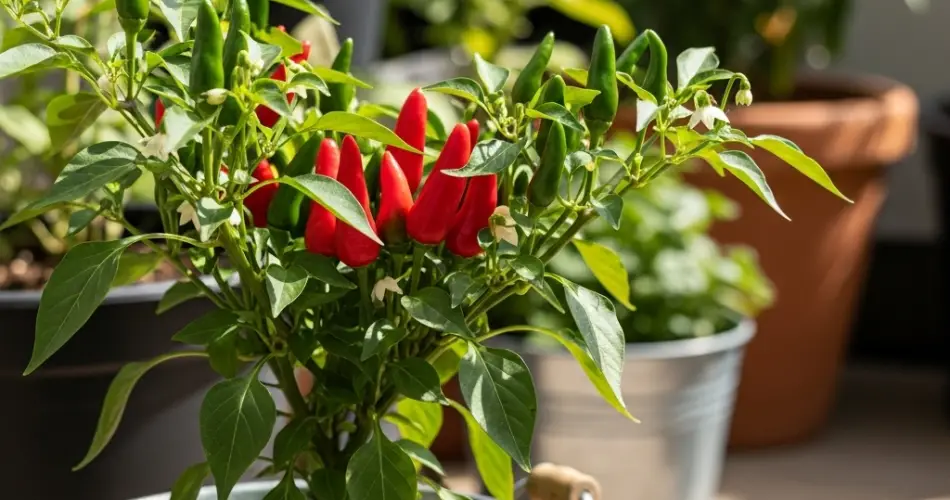For home gardeners and urban farmers, growing chilies in pots or buckets offers a convenient and rewarding way to enjoy fresh, spicy produce all year round. Even with limited space, container gardening allows you to cultivate a variety of chili peppers, from mild to fiery hot, without the need for a large garden. With the right care, these plants can thrive, producing abundant harvests that elevate your meals and bring the excitement of fresh heat to your kitchen.
Choosing the Right Containers
Selecting the appropriate container is the first step in successful chili cultivation. While chilies are relatively compact, they develop deep root systems that require sufficient space. Buckets or pots with a capacity of at least 5 gallons are ideal for most chili varieties. Ensure that the containers have drainage holes to prevent waterlogging, which can lead to root rot. Plastic, ceramic, or even repurposed buckets work well, as long as they provide stability and drainage.
Selecting Chili Varieties
The wide range of chili varieties means there’s something for every taste and skill level. Beginners may prefer milder types like cayenne or jalapeño, while more experienced gardeners might opt for habanero, Thai bird’s eye, or Scotch bonnet peppers. When selecting seeds or seedlings, consider your local climate, sunlight availability, and personal spice tolerance. Most chili plants require full sun, at least six to eight hours daily, to produce flavorful, vibrant fruit.
Soil and Fertilization
Healthy soil is essential for robust chili growth. Use a well-draining potting mix enriched with organic matter such as compost or coconut coir. Avoid garden soil, which can compact in containers and inhibit root development. To promote strong growth and abundant fruiting, feed your chilies regularly with a balanced liquid fertilizer. Fertilizers rich in potassium and phosphorus encourage flowering and fruit development, while nitrogen supports leafy growth in the early stages.
Planting and Spacing
When planting chilies in pots or buckets, start with seedlings rather than direct seeding for faster results. Fill the container with potting mix, leaving a few inches at the top, and plant one seedling per pot to reduce competition for nutrients and water. Position the plant in the center of the container and gently firm the soil around the roots. Space pots at least 12 to 18 inches apart if placed on a balcony or patio to allow adequate airflow, reducing the risk of fungal diseases.
Watering Practices
Consistent watering is crucial, as chilies are sensitive to both drought and overwatering. The soil should remain moist but not soggy. Water deeply once or twice a week, adjusting frequency according to temperature, rainfall, and container size. In hot weather, container soil can dry quickly, so monitoring moisture levels daily may be necessary. Mulching the soil surface with straw or shredded leaves helps retain moisture and regulate soil temperature.
Supporting Growth
Many chili varieties develop sturdy but tall stems that benefit from support. Use small stakes, cages, or trellises to keep the plant upright and prevent breakage from heavy fruit. Regular pruning of lower leaves and occasional pinching of the growing tips encourages bushier plants and more productive flowering. Removing early flowers when the plant is young can also help it establish stronger roots and foliage before focusing on fruit production.
Pest and Disease Management
Chilies in containers are less prone to pests than those in open garden beds, but vigilance is still important. Common issues include aphids, whiteflies, and spider mites. Inspect plants regularly and use organic solutions like neem oil or insecticidal soap when necessary. Avoid overwatering and ensure good airflow around pots to minimize the risk of fungal diseases such as powdery mildew and root rot.
Harvesting Chilies
The most rewarding part of container chili gardening is harvesting. Chilies can be picked when green or left to ripen to red, yellow, or orange, depending on the variety. Regular harvesting encourages continued fruit production. Use scissors or pruners to snip peppers from the plant to avoid damaging stems. Handle with care, as the oils from hot peppers can irritate skin and eyes.
Advantages of Container Chili Gardening
Growing chilies in pots and buckets offers several benefits. It allows gardeners to optimize space, control soil quality, and move plants to favorable sunlight or shelter during adverse weather. Container gardening also reduces weed competition and makes maintenance tasks like watering and fertilizing more manageable. Whether you’re growing a single plant on a windowsill or a small collection on a balcony, the satisfaction of harvesting homegrown chilies is immense.
Conclusion
Chilies are versatile, visually striking, and highly rewarding plants for container gardening. With the right containers, soil, sunlight, and care, even urban gardeners can enjoy a continuous supply of fresh, flavorful peppers. By nurturing your chili plants in pots or buckets, you not only enhance your culinary creations but also embrace a gratifying and manageable approach to home gardening. Spicy meals, vibrant colors, and the joy of harvest are all within reach with this simple yet effective method.



